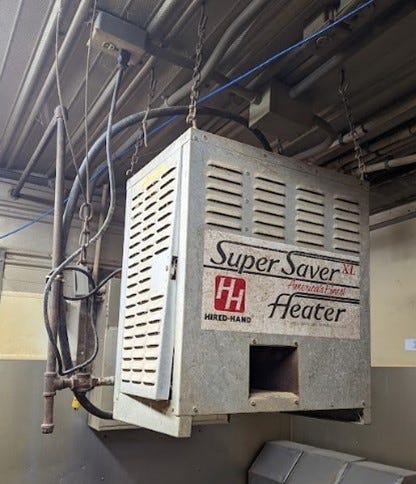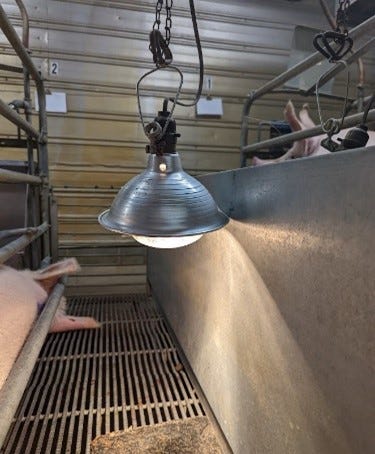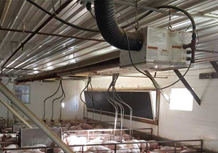Proper temperatures are critical during the post-weaning period so the piglets' immune systems can become resilient to disease.
January 5, 2023

The ideal air temperature for newly weaned pigs is around 83 degrees Fahrenheit, with an ideal flooring mat temperature of 95 degrees Fahrenheit. Required mat and air temperatures begin to gradually decrease seven days after placement. It is important to keep young pigs warm to improve growth and survivability.
At this stage of a pig's life, their immune systems are still developing and their energy intake at weaning is limited, reducing their ability to produce heat themselves. Therefore, reducing environmental stress can allow the pigs to devote less energy to thermoregulation. Proper temperatures are critical during the post-weaning period so the piglets' immune systems can become resilient to disease. Feed intake and feed conversion are impacted based on the temperature the piglets are kept in.
Though pigs themselves produce body heat, with small pigs it is often not enough warmth to maintain appropriate temperatures inside the pig facility. Instead, many nursery or wean-finish facilities use supplemental heating sources to make sure the pigs are housed at the correct temperature. Some of the most common heating sources used are forced air heaters, heat lamps, gas-fired brooders and radiant tubes.
Forced air heater
Forced air heaters are units that heat the whole room to a desired setpoint temperature. Unlike heat lamps, radiant tubes, and gas-fired brooders, the air is heated first which then warms the pigs. The unit brings in cooler air by recirculating room air, heating it up, and then pushing the warmed air into the room. These are commonly installed hanging from the ceiling in a few locations around the room, depending on room size and layout. Forced air heaters can also be wall mounted and use fresh outdoor air rather than recirculating room air.

This heating source uses combustion, creating by-products such as water vapor, carbon dioxide and carbon monoxide. As a result, some forced air heaters are vented, meaning these gases and byproducts are piped outside the building for release. Many heaters are not vented, meaning these compounds are released directly into the room where the heater is operating. One drawback of using only forced air heaters is the possibility of heated air loss through windows or cracks within the facility, and they take longer to heat up the floor surface compared to the other heating sources.
Heat lamp
A heat lamp uses radiant energy to directly heat surfaces, like the floor and the pigs' bodies, instead of heating the air. The lamp is suspended 2 to 4 feet above the floor. The closer the lamp is to the floor, the higher the temperature is but the smaller the heated area. The temperature can be regulated by adjusting the height the lamp is hanging. It should also be adjusted as the piglets grow.

A variety of incandescent, infrared and ceramic bulb options are commercially available. Common problems with the heat lamp are the bulbs breaking when they get wet and bulbs frequently burning out.
Gas-fired brooder
A brooder is similar to a heat lamp, just on a larger scale. Its radiant heat warms the surfaces and pigs. It can be powered by natural gas or propane. The brooder's shroud is usually made of stainless steel for easy cleaning to improve the life span. It should be placed 4-5 feet high above the piglets.

Radiant tube
A radiant tube also uses radiant heat to keep the pigs warm. The tubes directly heat the surfaces and pigs without heating the air in the entire room. It is placed 6 feet above the pigs, typically suspended near the ceiling. The tubes vary from 15 to 40 feet long and cover a larger heating area than heat lamps and brooders. Tubes can be angled to cover multiple pens at once or face directly downwards. Typically, one radiant tube is mounted slightly off-center along the length of the barn to cover pens on both sides of an alleyway. Radiant tubes can be expensive to install, although operating prices are low.

Regardless of heat source, post-weaning pig behaviors and postures can tell you if your pigs are at the appropriate temperature. If pigs are huddled very tightly and laying on top of one another, you can assume they are cold. If they are side by side, they are usually at a comfortable temperature. If the pigs are separated and trying to stay away from each other, this is a good indication that the temperature is too high.
Placing post-weaning pigs in proper environmental conditions is critical for pig success. The barn should be kept clean, dry and free of air drafts with a ventilation rate of at least 2 CFM per pig at placement and no more than 65% relative humidity. Regardless of heating source, it is recommended to provide about 0.4 ft2 per pig of heated area. Pre-heating the facility prior to pig arrival is needed to achieve these conditions, especially with concrete slats or in colder climates.
For additional information, visit NC State Swine Extension site or contact via email.
References:
Hog Slat. Accessed here.
National Hog Farmer. Industry Voice by Hog Slat: Tube heaters for weaned pigs. Published 10/01/21.
L.B. White Company, LLC. Accessed here.
Linhoss, J. Brooder elevation is important when heating broiler houses. Mississippi State University Extension.
PIC Wean to Finish Guidelines. 2019. PIC UK Ltd.
Samuel, R. 2020. Wean to finish heating for newly weaned pigs. South Dakota State University Extension.
Xin, H., Zhou, H., Bundy, D.S. 1997. Comparison of energy use and piglet performance between conventional and energy-efficient heat lamps. Applied Engineering in Agriculture, 13(1): 95-99.
You May Also Like



